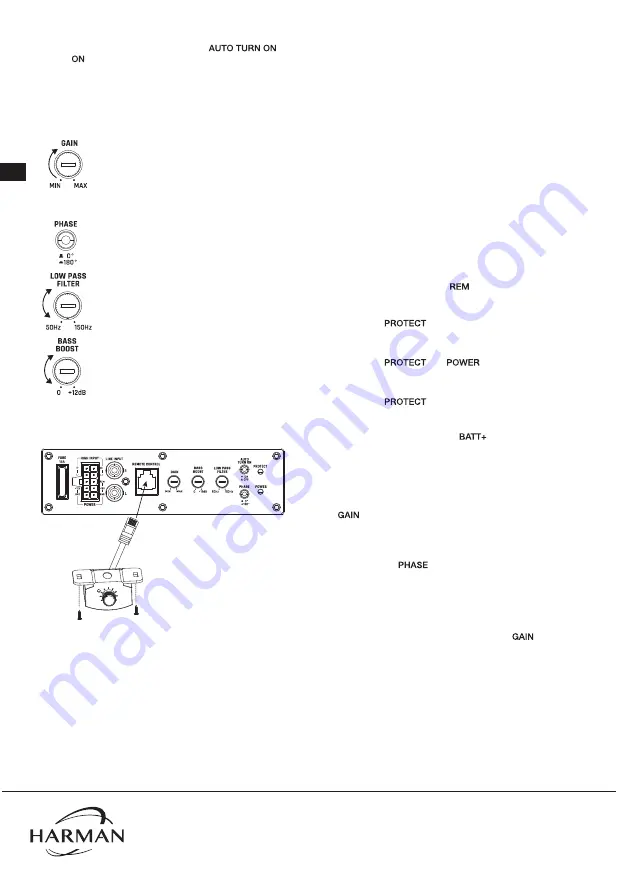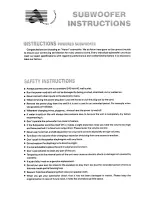
EN
Note:
When connecting a factory or aftermarket stereo to the
BassPro Nano’s speaker-level inputs, set the
button to
.
SETTING GAIN, ADJUSTING PHASE, LOW-
PASS FILTER, AND BASS BOOST
1.
Start with
GAIN
control set to minimum,
and the crossover control rotated midway.
2.
Choose music with substantial bass
content and turn the volume control on
your receiver to ¾ of its total output.
3.
Adjust the
GAIN
control clockwise,
listening carefully to the bass output. If
you hear distortion, turn the
GAIN
control
counterclockwise to decrease the
GAIN
.
4.
Switch the
PHASE
back and forth to
determine which setting provides the most
clean bass output.
5.
Adjust the
LOW-PASS
FILTER
control
until the BassPro Nano plays only low-
frequency information – you should not
hear elements such as vocals coming from
the woofer.
6.
Adjust the
BASS-BOOST
control
clockwise or counterclockwise to suit your
taste.
CONNECTING THE REMOTE BASS
CONTROL MODULE
SPECIFICATIONS
• Driver Complement: 6” x 8” (152mm x 203mm) woofer
• Amplifier Power Output: 100WRMS, 200W Max
• Frequency Response: 30 Hz – 150 Hz
• Fuse: 15A
• Maximum Current Draw: 13A
• Quiescent Current Draw: <600 mA
• Input Sensitivity: 0.1 V – 4.0 V low-level input; 0.25 V – 10V
high-level input
• Crossover Frequency: 50 Hz – 150 Hz
• Crossover Slope: 12 dB/octave
• Bass Boost: 0 dB to +12 dB @ 50Hz
• Dimensions (L x W x H): 10-1/4” x 7-11/16” x 2-15/16”
(260mm x 195mm x 74.6mm)
• Weight: 7.78lbs. (3.53kg)
TROUBLESHOOTING
No audio and
POWER
indicator is off
• No voltage at
BATT+
and/or
terminals, or bad or no
ground connection. Check voltages at amplifier terminals with
VOM
.
No audio and
indicator flashes every 4 seconds
• DC voltage on amplifier output. Amplifier may need service; see
enclosed warranty card for service information.
No audio and
and
indicators flash
• Voltage less than 9V on
BATT+
connection. Check vehicle
charging system.
No audio and
indicator is on
• Amplifier is overheated. Make sure amplifier cooling is not
blocked at mounting location. Or, there may be voltage greater
than 16V (or less than 8.5V) on
connection. Check
vehicle charging system.
Amplifier fuse keeps blowing
• The wiring is connected incorrectly or there is a short circuit.
Check wiring connections.
Distorted audio
•
is not set properly. Check setting. Check wires for shorts
or grounds. Amplifier or source unit may be defective.
Music lacks dynamics or “punch.”
• If using speaker-level inputs, check connections for proper
polarity. Switch
back and forth between 0° and 180°
and leave on setting with best sound.
Engine noise—whining or clicking—in system when the
engine is on
• Amplifier is picking up alternator noise. First, check ground
connection on the amplifier – a loose or improper ground is
one of the main causes for noise. Turn down
. Move RCA
audio cables away from power wires. Installing an alternator
noise filter on power line between battery and alternator might
also be necessary.
HARMAN International Industries,
Incorporated 8500 Balboa Boulevard,
Northridge, CA 91329 USA
www.jbl.com
© 2019 HARMAN International Industries, Incorporated. All rights reserved.
JBL is a trademark of HARMAN International Industries, Incorporated,
registered in the United States and/or other countries. Features, specifications
and appearance are subject to change without notice.





















